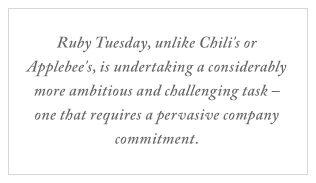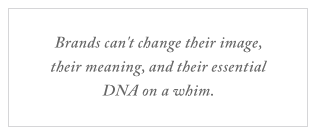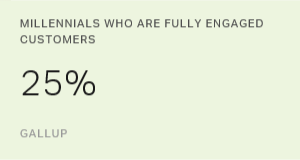From time to time, many companies must confront a tough reality: The world has changed, and consumers are seeking an experience that's markedly different from what the company has been offering. Your company may be the first name in buggy whips, but now you're dealing with a marketplace that no longer needs them. You may be famed for making spacious gas-guzzling SUVs, but car buyers are turning to hybrids and compact gas sippers. You may be selling daily newspapers to readers who increasingly look to Web sites for their news.
 |
Or your company may be a casual-dining chain trying to succeed in a crowded and intensely competitive category where many brands make similar promises. Familiar names are facing enormous challenges that threaten their very existence. The parent company of Bennigan's has filed for bankruptcy protection, sales at other chains are down, and The Cheesecake Factory reported a significant drop in same-store sales.
Can a downward sales spiral be reversed? What's a company to do?
Confronted with an audience that no longer appears to treasure what the company is offering, many marketers look first to their advertising. They know they need to change the way consumers think and feel about their brand and what they have to offer, so they look to their consumer communications for the solution. To address disappointing sales, Applebee's changed its advertising, launching a new TV campaign that featured a talking apple. In like manner, Chili's also changed its ads. And yet, in spite of the new high-profile ad campaigns that first aired last fall, sales at both chains have reportedly continued their slump.
Maybe advertising isn't the answer, whether you're selling casual dining, SUVs, or daily papers. Maybe it's not just about the promise; maybe it's also about the delivery.
Changing more than the ads
Having apparently learned a lesson from its casual-dining competitors, Ruby Tuesday has taken a more dramatic step, announcing that it's blowing up its old format and creating "a brand-new Ruby Tuesday." The company has changed the décor in its 900+ stores, replacing its previous interiors -- crammed with Tiffany lamps, movie posters, and hanging bicycles -- with a clean, uncluttered modern look. And beyond changing the physical appearance of its stores, Ruby Tuesday has also revised its menu and its promise, moving from what was a "bar and grill" theme to a new focus on what it has termed "simple, fresh, American dining."
Ruby Tuesday, unlike Chili's or Applebee's, is undertaking a considerably more ambitious and challenging task -- one that requires a pervasive company commitment. Ruby Tuesday isn't just changing its advertising promise; it's redefining the customer experience. Ruby Tuesday's repositioning is one that's supported not just by new advertising (promotion) but also by a discernibly different place and product.
Of course, there's another important "P" that must be taken into consideration, and that's the people who will be called upon to deliver the new Ruby Tuesday brand experience. While it's relatively easy to change staff uniforms in much the same manner as the company can change its interior fixtures, it's quite another thing to alter the manner in which the employees actually live the brand.
So that's another challenge that faces any company seeking to embrace what it believes will be the path to revitalized performance. That challenge centers on the all-important "brand ambassadors" who will be the ones delivering the menu items and, more importantly, helping to define and enhance the customer's brand experience. (See "Who Are Your Promise Keepers?" in the "See Also" area on this page.)
In recognition of this added challenge, Ruby Tuesday needs to get the company's brand ambassadors in alignment, living the new brand promise every bit as much as the company's redesigned décor and the new menu. Ruby Tuesday will be relying on its employees to deliver something noticeably different from the old "bar and grill" experience -- one that will further fulfill and reinforce the company's new brand promise. (See "The Power of the Fifth P" in the "See Also" area on this page.)
Start from the beginning
There's yet another consideration for Ruby Tuesday -- or for any company aiming to occupy a new and redefined position in the hearts and minds of consumers. It's important to note that Ruby Tuesday isn't starting down this new path with a totally blank slate. Ruby Tuesday isn't a new brand, and like many a familiar brand, it already has an established image. The existing Ruby Tuesday brand image cannot simply be ignored, and the company must consider the extent to which the intended new image ("simple, fresh") represents a reasonably strong fit with the image that already exists.
 |
As marketers look to their ultimate destination, they must always look first to their starting point. If the end appears to be a sharp disconnect from the start, that's a huge barrier that can't be overcome in one fiscal quarter (or two or three).
As we've discussed in previous GMJ articles, any brand promise must overcome three important hurdles. The foundational hurdle is one of credibility. Before the brand can hope to connect with a prospect or reconnect with a lapsed customer, its promise must be deemed credible. Credibility takes into account what the consumer already thinks of your brand, and that determines in large part the consumer's receptivity to a new, redefined promise.
VW was unable to successfully launch the luxury Phaeton in the United States -- not because the product wasn't terrific and the promise had no appeal. Rather, it was because VW's well-established brand image and the perception of the VW dealer experience didn't credibly translate into the world of luxury. VW's image didn't support the promise of its upscale Phaeton offering. (See "Stretching the Brand Until it Breaks?" in the "See Also" area on this page.)
Change takes time
As Ruby Tuesday embarks on the creation of an entirely new brand promise, there's one more item for customers and investors to consider. The company may spend a good deal of money memorably communicating its new promise to the intended audience. It may support that promise with a redesigned and reinvigorated brand experience that includes how the brand looks, how it smells and tastes, and even how it feels.
Ruby Tuesday may align an entire laundry list of marketing "Ps" that includes people, product, place, price, and promotion, as well as process and policy. But there's one final "P," and without it, there will be no success. It's a "P" that may be in short supply among marketers who are asked to support the wisdom of their decisions based on next Monday morning's sales report. That "P" is patience.
A brand's marketplace position isn't just a reflection of a company's intentions. What really matters are consumers and how they view the brand. Getting consumers to accept and embrace a redefined brand promise isn't something that can be achieved overnight. Images are slow to change and, in truth, fight against change. That's part of their value: They're enduring. So companies that seek to redefine what they mean to consumers must confront the fact that change won't happen nearly as quickly as the company might hope.
Brands can't change their image, their meaning, and their essential DNA on a whim, nor can they expect turnaround business results as an immediate consequence. Short-lived brand redefinitions will not result in an enduringly established position nor in sustainable business results. Consumers need to know what the brand truly stands for, not just for the coming few weeks, but for the years to come.
Ruby Tuesday, unlike a good many of its competitors, has recognized the fact that a redefined brand positioning cannot be undertaken lightly, nor pursued half-heartedly. And, like many a journey, the destination isn't reached in a single step. But that's where it must begin.
